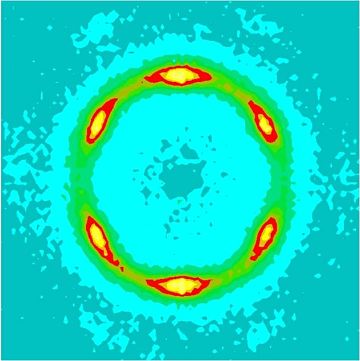Neutron Scattering: A Powerful Technique for Analyzing Nanomaterials
What is Neutron Scattering?
Neutron scattering is a powerful analytical technique that utilizes neutrons to probe the structure, dynamics, and properties of materials at the atomic and nanoscale level. It provides unique insights into the arrangement of atoms, molecules, and magnetic moments in a wide range of materials, including nanomaterials, biological systems, and complex fluids.

Principles of Neutron Scattering
Neutron scattering relies on the interaction between neutrons and the nuclei and magnetic moments in a sample. When a beam of neutrons is directed towards a sample, the neutrons can be scattered elastically (without energy change) or inelastically (with energy change) depending on the nature of the interaction.
Elastic Scattering
In elastic scattering, the neutrons are scattered without changing their energy. This type of scattering provides information about the static structure of the sample, such as the atomic positions, lattice parameters, and long-range order. Techniques like small-angle neutron scattering (SANS) and neutron diffraction utilize elastic scattering to study the structure of nanomaterials.
Inelastic Scattering
Inelastic scattering involves a change in the energy of the scattered neutrons. This type of scattering provides information about the dynamics and excitations in the sample, such as phonons (lattice vibrations), magnons (spin waves), and molecular vibrations. Techniques like inelastic neutron scattering (INS) and quasielastic neutron scattering (QENS) utilize inelastic scattering to study the dynamics of nanomaterials.
Advantages of Neutron Scattering
Neutron scattering offers several unique advantages compared to other analytical techniques:
- Penetration Depth: Neutrons have a high penetration depth, allowing them to probe the bulk properties of materials. This is particularly useful for studying nanomaterials embedded in a matrix or buried interfaces.
- Sensitivity to Light Elements: Neutrons are sensitive to light elements like hydrogen, oxygen, and lithium, which are often difficult to detect using X-rays. This makes neutron scattering an invaluable tool for studying organic nanomaterials, biological systems, and energy storage materials.
- Isotopic Contrast: Neutrons can distinguish between different isotopes of the same element due to their different scattering cross-sections. This enables the use of isotopic substitution to selectively highlight specific components in a complex system.
- Magnetic Sensitivity: Neutrons have a magnetic moment and can interact with the magnetic moments in a sample. This allows neutron scattering to probe the magnetic structure and dynamics of nanomaterials, which is crucial for studying spintronic devices and magnetic nanoparticles.
Applications of Neutron Scattering in Nanotechnology
Neutron scattering techniques are widely used in nanotechnology to characterize and understand the properties of nanomaterials. Some key applications include:
Nanoparticle Characterization
Small-angle neutron scattering (SANS) is used to study the size, shape, and distribution of nanoparticles in solution or embedded in a matrix. It provides information about the average size, polydispersity, and interactions between nanoparticles. SANS is particularly useful for studying the self-assembly and aggregation behavior of nanoparticles.
Thin Film and Interface Analysis
Neutron reflectometry is a technique used to study the structure and composition of thin films and interfaces at the nanoscale. It provides depth-resolved information about the thickness, density, and roughness of layers in a thin film stack. Neutron reflectometry is widely used to study the interfacial properties of functional nanomaterials, such as those used in solar cells, sensors, and catalysts.
Soft Matter and Biomaterials
Neutron scattering is an invaluable tool for studying the structure and dynamics of soft matter and biomaterials at the nanoscale. Techniques like SANS, QENS, and neutron spin echo (NSE) are used to investigate the conformation, interactions, and dynamics of polymers, proteins, lipid membranes, and other biological nanostructures. This information is crucial for designing functional nanomaterials for drug delivery, tissue engineering, and biosensing applications.
Challenges and Future Perspectives
Despite the immense potential of neutron scattering in nanotechnology, there are challenges that need to be addressed. One of the main limitations is the availability of high-flux neutron sources, as neutron scattering experiments require intense neutron beams. The development of advanced neutron sources, such as spallation sources and compact accelerator-based neutron sources, is crucial for expanding the accessibility and capabilities of neutron scattering techniques.
Future research in neutron scattering will focus on the development of novel instrumentation and data analysis methods to enhance the resolution, sensitivity, and throughput of neutron scattering experiments. The integration of computational modeling and machine learning techniques will enable the rapid interpretation and analysis of complex neutron scattering data. Additionally, the combination of neutron scattering with complementary techniques, such as X-ray scattering and electron microscopy, will provide a more comprehensive understanding of the structure-property relationships in nanomaterials.
Further Reading
Physical Chemistry Chemical Physics, Neutron scattering in catalysis and energy materials
Acta Crystallographica Section D, Neutron scattering in the biological sciences: progress and prospects
Nature Reviews Methods Primers, Small-angle X-ray and neutron scattering
